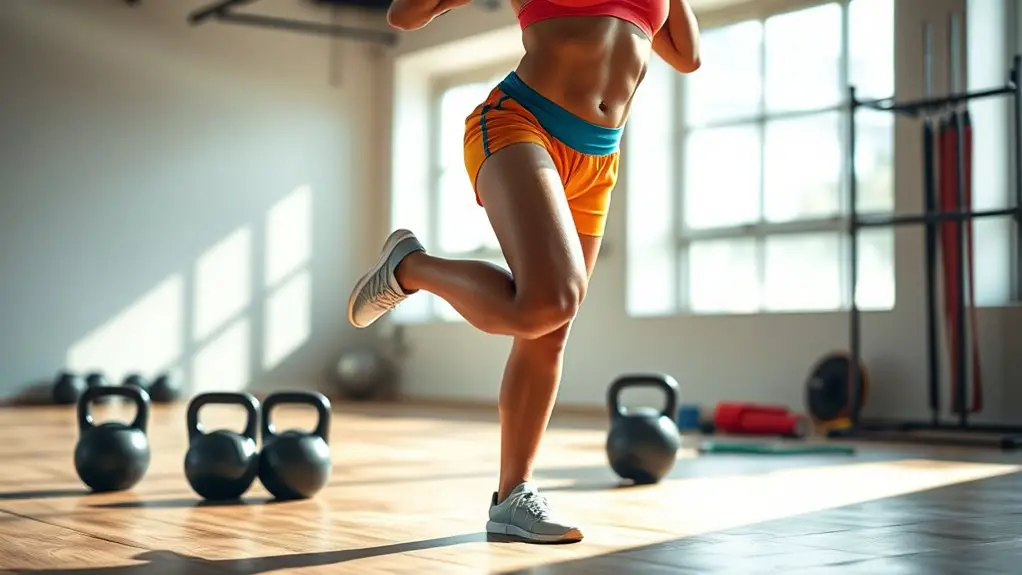Unilateral exercises are key to fixing muscle imbalances because they work each side of your body independently, boosting strength and stability. Start with the single-arm dumbbell row, single-leg deadlift, and Bulgarian split squat to enhance symmetry. Don't forget the single-leg glute bridge and single-arm dumbbell chest press to develop core strength and control. Ultimately, the side plank with leg raise can improve overall stability. Keep exploring to uncover more effective exercises and techniques to balance your strength.
Understanding Muscle Imbalances
Muscle imbalances can sneak up on you, often developing over time due to repetitive movements or poor posture. When one side of your body becomes stronger than the other, it can lead to muscle asymmetry, affecting your overall strength and performance. To regain that sense of freedom in your movements, you've got to understand these imbalances.
A proper strength assessment helps identify which muscles are underactive or overactive. By pinpointing these discrepancies, you can take the necessary steps to restore muscle symmetry. It's crucial to listen to your body, as it often signals when something's off. Engaging in unilateral exercises can be a game changer, allowing you to train each side independently. This focused approach not only balances your muscle strength but also enhances your functional capabilities. Furthermore, incorporating mobility training into your routine can further improve your movement efficiency. Embracing this journey will empower you to move more freely and confidently in your daily life.
Benefits of Unilateral Exercises
While many people focus on bilateral exercises to build overall strength, incorporating unilateral exercises can offer unique benefits that enhance your training regimen. By emphasizing one side at a time, you'll not only improve muscle symmetry but also enjoy these advantages:
- Injury Prevention: Strengthening each side individually helps address weaknesses, reducing the risk of injuries caused by imbalances.
- Enhanced Core Stability: Unilateral movements engage your core more intensely, leading to improved balance and stability during all activities.
- Greater Functional Strength: You'll build strength that translates into real-life movements, making everyday tasks easier and more enjoyable.
Additionally, strong, healthy joints are critical for reaching full athletic potential, making unilateral exercises a valuable addition to your routine. Embracing unilateral exercises can free you from the constraints of standard workouts, allowing you to discover new strengths and capabilities. So, whether you're looking to fix muscle imbalances or simply want to elevate your fitness game, these exercises are essential for a well-rounded approach.
Single-Arm Dumbbell Row
Transform your upper body strength with the Single-Arm Dumbbell Row, a powerful unilateral exercise that targets your back, shoulders, and arms. This exercise not only builds muscle but also corrects imbalances, giving you the freedom to move with confidence. By incorporating single arm variations, you can focus on one side at a time, ensuring each muscle group gets the attention it needs.
To perform the Single-Arm Dumbbell Row, position yourself with one knee and hand on a bench, and let the other arm hang straight down, holding the dumbbell. Engage your core, and pull the weight towards your hip using proper rowing techniques. This motion not only strengthens your upper body but also enhances your stability and posture. Additionally, a strong core supports the spine during exertion, reducing the risk of injury. As you progress, feel free to increase weights or reps, challenging yourself while maintaining control. Embrace the journey towards balanced strength and freedom in your movements!
Single-Leg Deadlift
The single-leg deadlift is a powerful exercise that can help you address muscle imbalances and improve overall stability. By focusing on proper form techniques, you'll not only maximize the benefits but also reduce the risk of injury. This exercise engages multiple muscle groups for overall strength, which is crucial for enhancing athletic performance. Let's explore how this exercise can enhance your strength and balance.
Benefits of Single-Leg Deadlift
One of the standout benefits of the single-leg deadlift is its ability to enhance stability and balance. By incorporating this exercise into your routine, you can experience profound freedom in movement. You'll find that it not only improves your single leg stability but also activates your core, giving you a solid foundation for all activities.
Here are three emotional benefits to reflect on:
- Empowerment: Mastering this exercise boosts your confidence and gives you control over your body.
- Resilience: As you build strength, you'll feel more capable of tackling physical challenges in life.
- Freedom: Enhanced balance means you can move through life without the fear of stumbling or falling.
Embrace the single-leg deadlift and release your potential!
Proper Form Techniques
To achieve the maximum benefits from the single-leg deadlift, it's vital to maintain proper form throughout the movement. Start by standing tall with your feet hip-width apart, engaging your core. As you hinge at your hips, keep your back straight and your chest up, ensuring correct posture. Shift your weight onto one leg while extending the opposite leg behind you, lowering your torso and the weight toward the ground. Your standing knee should remain slightly bent to promote stability. Keep your shoulders squared and avoid twisting your torso. As you return to standing, focus on using your glutes and hamstrings. This attention to form not only enhances effectiveness but also plays a significant role in injury prevention, allowing you to train freely and confidently.
Bulgarian Split Squat
Although often underestimated, the Bulgarian split squat is a powerful unilateral exercise that effectively addresses muscle imbalances. By mastering the Bulgarian technique, you can reveal a world of Bulgarian benefits that will elevate your fitness routine. Here's why you should embrace this exercise:
The Bulgarian split squat is an underrated powerhouse, perfect for balancing strength and enhancing your fitness journey.
- Strengthens each leg independently – This helps guarantee that one side doesn't dominate, promoting balance and symmetry.
- Enhances flexibility – The deep lunge position opens up your hips, improving your overall range of motion.
- Boosts core stability – As you engage your core to maintain balance, you'll build strength that translates to other lifts.
Additionally, incorporating Bulgarian split squats into your training promotes improved flexibility that supports greater overall agility and game elevation. Incorporating Bulgarian split squats into your training will give you the freedom to move more efficiently, both in and out of the gym. So, take the plunge, and experience the transformative power of this underrated gem!
Single-Arm Overhead Press
The single-arm overhead press is an excellent unilateral exercise that targets your shoulders, triceps, and core while addressing muscle imbalances effectively. By focusing on one arm at a time, you'll enhance your shoulder strength and promote muscle stability throughout your entire upper body. This exercise challenges your balance, forcing your core to engage, which helps improve overall body control.
To perform the single-arm overhead press, stand tall with your feet shoulder-width apart. Hold a dumbbell in one hand at shoulder height, palm facing forward. Press the weight overhead until your arm is fully extended, then lower it back to the starting position. Switch arms and repeat.
Incorporating this movement into your routine not only boosts your shoulder strength but also helps correct any asymmetries. Additionally, remember that rest days are essential for recovery, allowing your muscles to rebuild and grow stronger. So, grab that dumbbell, and experience the freedom of balanced strength!
Single-Leg Glute Bridge
The Single-Leg Glute Bridge is a fantastic exercise for targeting your glutes while addressing muscle imbalances. To get the most out of it, you'll want to focus on proper form to guarantee effectiveness and prevent injury. Let's explore the benefits and the key instructions for performing this move correctly. Additionally, incorporating caffeine's role in pre-workout nutrition can further enhance your performance during this exercise.
Benefits of Single-Leg Glute Bridge
While many exercises focus on both legs, the single-leg glute bridge offers unique benefits that can help address muscle imbalances and enhance overall strength. By incorporating this exercise into your routine, you'll not only improve your glute activation but also foster hip stability.
Here are three key benefits you'll experience:
- Correct Muscle Imbalances: You'll engage each side of your body independently, promoting balanced strength.
- Enhanced Core Engagement: You'll activate your core to stabilize your body, leading to better overall performance.
- Increased Functional Strength: You'll build strength that translates to daily activities, giving you the freedom to move with confidence.
Embrace the single-leg glute bridge, and feel the difference it makes in your journey toward a stronger, more balanced you!
Proper Form Instructions
To perform a single-leg glute bridge correctly, start by lying on your back with your knees bent and feet flat on the floor, hip-width apart. Press through your heels as you lift one leg, extending it straight up. Engage your core and push your hips toward the ceiling, squeezing your glutes at the top. Keep your shoulders relaxed and avoid arching your back. Hold for a moment, then lower back down with control. This corrective exercise helps address muscle asymmetry by targeting each side of your body individually. Switch legs and repeat. Remember, maintaining proper form is key to maximizing benefits and ensuring safety. Enjoy the freedom of movement and the strength you're building!
Single-Arm Dumbbell Chest Press
When you incorporate the single-arm dumbbell chest press into your workout routine, you not only enhance strength in your chest but also address muscle imbalances that can arise from favoring one side during exercises. This movement promotes muscle activation, allowing you to focus on each side independently, fostering strength symmetry.
Here are three powerful benefits of this exercise:
- Builds Balanced Strength: You'll develop your chest evenly, minimizing weaknesses that can limit your performance.
- Improves Stability: By engaging your core and stabilizing muscles, you'll enhance overall strength and control.
- Boosts Confidence: As you notice improvements in your strength and form, you'll feel empowered and ready to tackle challenging workouts.
Additionally, this exercise enhances core stability, which is crucial for maintaining control during dynamic movements. Embrace the freedom to move without limitations, and let the single-arm dumbbell chest press guide you toward a stronger, more balanced physique. It's time to break free from imbalances and release your full potential!
Side Plank With Leg Raise
Building on the strength and stability gained from the single-arm dumbbell chest press, the side plank with leg raise takes your core training to the next level. This move enhances core stability while challenging your balance, making it an effective exercise for addressing muscle imbalances.
Here's a quick overview of the side plank with leg raise:
| Step | Action | Focus |
|---|---|---|
| 1 | Position yourself in a side plank | Core activation |
| 2 | Raise your top leg | Glute engagement |
| 3 | Hold and breathe | Stability maintenance |
Incorporating side plank variations like this one not only builds strength but also promotes freedom of movement. You'll feel the difference as your core becomes more resilient, allowing you to perform daily activities with ease. Additionally, this exercise helps in restoring body alignment and correcting postural imbalances. Embrace this challenge and watch your body transform!
Frequently Asked Questions
How Often Should I Perform Unilateral Exercises for Best Results?
Did you know that nearly 70% of people have muscle imbalances? To address this, aim for a workout frequency of 2-3 times per week for unilateral exercises. This frequency allows your muscles to recover while effectively targeting those imbalances. Listen to your body, adjusting as needed, and remember to mix up your routine for best results. By prioritizing consistency, you'll enjoy the freedom of balanced strength and improved performance in your activities.
Can Unilateral Exercises Help With Posture Correction?
Absolutely, unilateral exercises can help with posture correction. By focusing on one side of your body at a time, you're promoting better muscle alignment and addressing any imbalances. This can lead to improved posture benefits as your core and stabilizing muscles engage more effectively. You'll find that as you strengthen these areas, you'll feel more balanced and free in your movements, ultimately enhancing your overall stability and alignment.
Are Unilateral Exercises Safe for Beginners?
Oh, sure, why wouldn't unilateral exercises be safe for beginners? Just balancing on one leg while lifting weights is totally foolproof, right? But in reality, they can be quite safe if you focus on proper exercise form. As a beginner, it's vital to prioritize safety and start slow. Listen to your body, and don't rush into advanced movements. With practice, you'll build strength and confidence, paving the way for a freer, more empowered workout experience.
How Do I Know if I Have a Muscle Imbalance?
To know if you've got a muscle imbalance, start with symptom identification. Pay attention to any discomfort or weakness in one side of your body during activities. You can also use assessment techniques like observing how you perform movements; if one side feels weaker or looks different, it's a sign. Trust your body's signals, and don't hesitate to consult a professional if you're unsure. Freedom in movement comes from understanding your body's needs!
Should I Prioritize Unilateral Exercises Over Bilateral Ones?
Imagine your body as a finely tuned instrument, each part harmonizing with the others. Prioritizing unilateral exercises can enhance this balance, spotlighting unilateral benefits like improved strength and coordination. While bilateral exercises have their place, they often mask underlying issues, revealing bilateral drawbacks. By embracing unilateral training, you'll liberate your body from imbalances, allowing it to move freely and efficiently. So, consider weaving unilateral workouts into your routine for a more harmonious performance.




